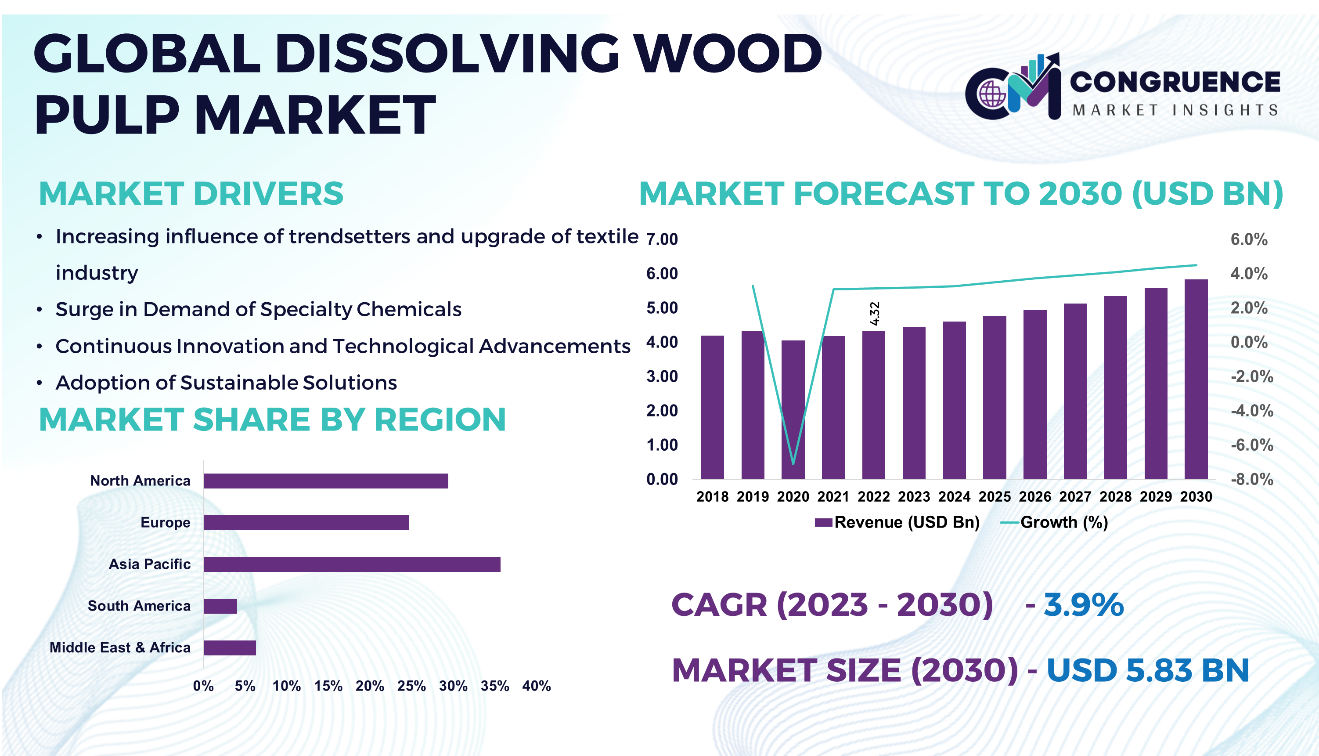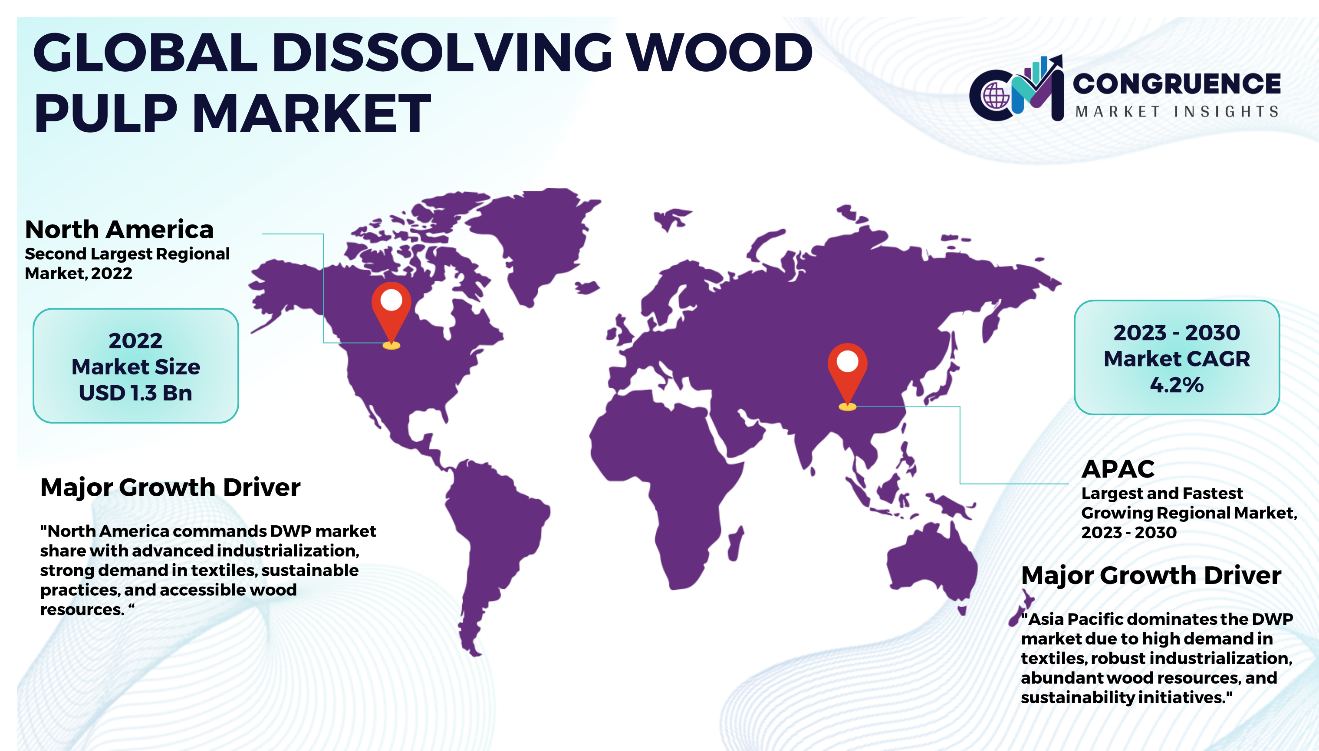Reports
The Global Dissolving Wood Pulp (DWP) Market was valued at USD 4.32 Billion in 2022 and is anticipated to reach a value of USD 5.83 Billion by 2030 expanding at a CAGR of 3.9% between 2023 and 2030.
The dynamic dynamics of the global Dissolving Wood Pulp (DWP) market are primarily driven by the escalating demand for versatile cellulose-based products. DWP serves as a pivotal raw material with extensive applications across diverse industries, particularly in textiles, films, and specialty chemicals. The market is exhibiting a pattern of sustained growth, attributed to the increasing adoption of sustainable and eco-friendly materials within manufacturing processes. High-Alpha DWP, acknowledged for its heightened levels of purity and strength, plays a significant role in the production of premium-grade viscose fibers employed in textiles and specialty chemicals. In response to the growing emphasis on sustainability, manufacturers are actively exploring eco-friendly practices and cutting-edge technologies in DWP production.
Key industry stakeholders hold crucial positions in influencing and directing the trajectory of the market. Strategic initiatives, encompassing mergers, acquisitions, and partnerships, are prevalent strategies pursued with the objective of fortifying production capabilities and expanding market reach. The market dynamics are further shaped by technological advancements, regulatory policies, and evolving consumer preferences, highlighting the industry's adaptability. With an unwavering commitment to innovation and sustainable practices, the global DWP market is poised for sustained growth, retaining its integral role in the production of essential materials across diverse sectors and adeptly addressing the evolving demands of a wide spectrum of end-use applications.

Dissolving Wood Pulp (DWP) Market Major Driving Forces
Increasing influence of trendsetters and upgrade of textile industry: The pervasive use of Dissolving Wood Pulp in the textile sector stands as a prominent driver for its demand. DWP serves as a fundamental raw material in the creation of viscose rayon fibers, integral to textile and apparel manufacturing processes.
Surge in Demand of Specialty Chemicals: Another compelling factor driving the Dissolving Wood Pulp market is its increased utilization in the production of specialty chemicals. High-Alpha DWP, recognized for its purity and robustness, finds favor in the creation of cellulose derivatives for diverse chemical applications.
Continuous Innovation and Technological Advancements: Sustained growth in the Dissolving Wood Pulp market is fostered by perpetual innovation and technological advancements in its production processes. Ongoing efforts to enhance efficiency, minimize environmental impact, and elevate product quality serve as pivotal driving forces.
Adoption of Sustainable Solutions: A growing awareness and focus on sustainability in manufacturing processes play a crucial role in driving the demand for Dissolving Wood Pulp. Manufacturers are increasingly choosing sustainable materials, and the environmentally friendly characteristics of DWP, stemming from its renewable and biodegradable nature, harmonize seamlessly with this evolving trend.
Dissolving Wood Pulp (DWP) Market Key Opportunities
Surging Interest in Sustainable Textiles: The upward trajectory of consumer awareness surrounding sustainability and eco-friendly choices has instigated a rising demand for textiles crafted from environmentally conscious materials. Dissolving Wood Pulp (DWP), given its pivotal role in producing sustainable viscose fibers, is strategically positioned to harness this trend, particularly within the realm of fashion and apparel.
Diverse Integration in Specialty Chemicals: The escalating demand for specialty chemicals in sectors ranging from pharmaceuticals to cosmetics and food presents an opportunity for the expanded integration of DWP. The remarkable purity of High-Alpha DWP positions it as a valuable resource for crafting high-quality cellulose derivatives tailored to meet the specific requirements of these diverse applications.
Continuous Evolution in DWP Production Methods: Persistent innovation and technological advancement within DWP production processes create pathways for enhancing efficiency, mitigating environmental impact, and overall product quality improvement. Manufacturers can explore inventive and advanced methodologies to sustain competitiveness in the market.
Exploration of Varied End-Use Applications: Exploring novel and varied end-use applications beyond traditional sectors such as automotive, construction, and packaging provides avenues to access untapped markets for Dissolving Wood Pulp (DWP). Strategically meeting the distinctive requirements of these industries creates opportunities for growth.
Dissolving Wood Pulp (DWP) Market Key Trends
· Ongoing innovation and technological advancements in DWP production processes are prevalent trends.
· There is a noticeable uptick in the demand for sustainable and eco-friendly materials across industries. DWP, being a renewable and biodegradable resource, aligns with this trend, driving its increased adoption in various applications.
· DWP is expanding its footprint beyond traditional end-use industries like textiles.
· The DWP market is witnessing increased investment in research and development. This trend underscores the industry's commitment to discovering new applications, improving existing processes, and staying at the forefront of technological advancements.
· Industries such as pharmaceuticals, cosmetics, and specialty chemicals are increasingly leveraging the unique properties of High-Alpha DWP.
Region-wise Market Insights
Asia Pacific accounted for the largest market share at 35.6% in 2022 and is expected to register the fastest growth, expanding at a CAGR of 4.2% between 2023 and 2030. On the other hand, Europe is expected to generate approximately USD 1.0 Bn in 2022.

The Dissolving Wood Pulp (DWP) market demonstrates diverse trends across different regions, a reflection of distinct influences such as industrialization, economic development, and localized demand dynamics. In well-established markets like North America and Europe, the focus on sustainable practices and environmentally friendly materials has spurred the integration of DWP, particularly in sectors such as textiles and specialty chemicals. The Asia-Pacific region, notably China, plays a pivotal role in the DWP market, experiencing a notable surge in demand for viscose fibers within the textile industry. South America, the Middle East, and Africa present promising avenues for market expansion, propelled by a blend of economic growth and a heightened awareness of sustainable materials. The intricate interplay of each region's unique industrial landscape and consumer preferences adds complexity to the dynamics of the DWP market. As a result, industry stakeholders must meticulously tailor their strategies, drawing insights from the specific characteristics and opportunities present in each region to ensure relevance and success in the global market landscape.
Segment-wise Market Analysis
· Softwood DWP tend to be the largest segment in the DWP market. Boasting superior cellulose content and elongated fibers, DWP derived from softwood exhibits heightened strength and purity, establishing it as the preferred option in sectors such as textiles and specialty chemicals. The versatility and desirable properties of softwood DWP position it as a primary contender, effectively addressing the varied requirements across multiple end-use sectors and playing a substantial role in shaping the overall market share.
· Clothing and fabrics exert dominance in the Dissolving Wood Pulp (DWP) market due to the versatile applications of DWP in textile production. DWP, especially softwood-derived variants, contributes significantly to the creation of high-quality viscose fibers, making it a preferred choice for the fashion and apparel industry. The unique properties of DWP, including strength and purity, enhance the quality of fabrics, positioning clothing and fabrics as key drivers in the DWP market.
Market Competition Landscape
The global Dissolving Wood Pulp (DWP) market is characterized by intense competition, as leading players vie for dominance. Sappi, a distinguished participant, distinguishes itself through innovative and sustainable pulp production methods, bolstering its robust market presence. Nippon Paper Industries Co., Ltd., a significant Japanese player, brings extensive industry experience and expertise to the competitive arena. Lenzing AG strategically competes with a focus on environmentally friendly practices, particularly emphasizing sustainability in dissolving wood pulp production.
Bracell, emphasizing sustainable sourcing, contributes to the competitive landscape in line with the rising demand for eco-conscious materials. Grasim Industries Limited, recognized for its diverse portfolio, further enriches the competitive dynamics, catering to a broad spectrum of applications. Fulida Group Holding Co., Ltd., with its comprehensive range of cellulose products, plays a pivotal role in shaping market trends. Daicel Corporation, specializing in specialty pulp, enhances competition by offering unique solutions across various industries.
In addition to these major players, a diverse array of contributors collectively holds sway over the global Dissolving Wood Pulp (DWP) market. The competitive landscape is marked by innovation, sustainability endeavors, and strategic maneuvers, reflecting the efforts of industry leaders to navigate the ever-changing terrain. Their objective is to secure market leadership and remain adaptable to the evolving preferences of both consumers and the industry.
Key players in the global DWP market implement various organic and inorganic strategies to strengthen and improve their market positioning. Prominent players in the market include:
· Sappi
· Nippon Paper Industries Co., Ltd.
· Lenzing AG
· Bracell
· Grasim Industries Limited
· Fulida Group Holding Co., Ltd.
· Daicel Corporation
· Others
|
Report Attribute/Metric |
Details |
|
Market Revenue in 2022 |
USD 4.32 Billion |
|
Market Revenue in 2030 |
USD 5.83 Billion |
|
CAGR (2023 – 2030) |
3.9% |
|
Base Year |
2022 |
|
Forecast Period |
2023 – 2030 |
|
Historical Data |
2018 to 2022 |
|
Forecast Unit |
Value (US$ Bn) |
|
Key Report Deliverable |
Revenue Forecast, Growth Trends, Market Dynamics, Segmental Overview, Regional and Country-wise Analysis, Competition Landscape |
|
Segments Covered |
· By Type (Softwood DWP, Hardwood DWP, High-Alpha DWP, and Low-Alpha DWP) · By Application (Clothing and Fabrics, Films and Membrane Manufacturing, Specialty Chemicals, Drug-delivery systems and Coatings, and Others) · By End Use Industry (Textile, Chemical, Pharmaceutical, and Others) |
|
Geographies Covered |
North America: U.S., Canada and Mexico Europe: Germany, France, U.K., Italy, Spain, and Rest of Europe Asia Pacific: China, India, Japan, South Korea, Southeast Asia, and Rest of Asia Pacific South America: Brazil, Argentina, and Rest of Latin America Middle East & Africa: GCC Countries, South Africa, and Rest of Middle East & Africa |
|
Key Players Analyzed |
Sappi, Nippon Paper Industries Co., Ltd., Lenzing AG, Bracell, Grasim Industries Limited, Fulida Group Holding Co., Ltd., Daicel Corporation, and Others |
|
Customization & Pricing |
Available on Request (10% Customization is Free) |
